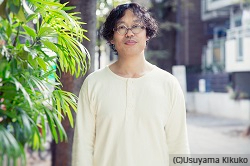Crossing Borders, Engaging in Exchanges and Harnessing the Power of Creation amid COVID-19
Interview and Contribution Series <9> Final Issue
Okada Toshiki, Playwright, Novelist, and Director of chelfitsch
November 29, 2021
[Special Feature 073]
In this ninth and final issue of our special feature "Crossing Borders, Engaging in Exchanges and Harnessing the Power of Creation amid COVID-19" (click here for a special feature overview), we welcome Okada Toshiki, a playwright highly respected both in Japan and abroad for his works that expand the concept of plays and critically remark on modern society. What are his thoughts on playwriting, travel, interactions and expanding plays during the pandemic, and what form will plays take on going forward?
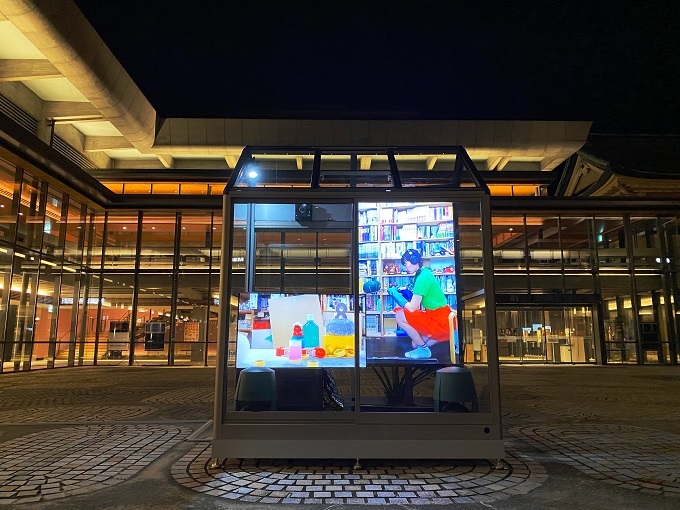 chelfitsch & Kaneuji Teppei "Eraser Fields" at ROHM Theatre Kyoto
chelfitsch & Kaneuji Teppei "Eraser Fields" at ROHM Theatre Kyoto――What have you been doing since the pandemic started?
The creative activities, performances and tours that were planned have all been postponed. Pre-pandemic, it was travel followed by more travel, but that came to a sudden stop at the end of March 2020, and since then, I've been taking it easy at my home in Kumamoto. I've cooked every day. For some of my projects, even though they were postponed, I've worked on their creation online. I've done things that I wouldn't have even considered before the pandemic.
With my production company, chelfitsch, we had planned for a spring and autumn European tour in 2020 of "Eraser Mountain," which made its debut in Kyoto in 2019, but that was postponed until 2021. We just barely managed to have the New York performances at the end of February. That said, we did get affected by the pandemic: A variety of stage props for the set design that had been loaded onto a ship didn't arrive in New York in time. We were quite frantic dealing with that, but we were still able to hold the performance. Right after that, infections exploded in New York, so I think we were quite lucky in that respect.
Having to wait as the "Eraser Mountain" plan disappeared and wanting to try something new because of, and in spite of, the situation, the members involved in "Eraser Mountain" and I started "Eraser Fields,"*¹ an initiative that we hadn't thought of originally. I hope you will actually see it to understand what it is, but simply put, "Eraser Mountain" was an initiative to create a play with an outlook on the world that shed a spotlight on objects. As opposed to the currently dominant human-centric world view, we wanted to explore something different, something that features objects on the same level or maybe even higher than humans.
With this same concept, we also held "Eraser Forest," an exhibition with many performance elements, at the 21st Century Museum of Contemporary Art, Kanazawa. With that same spirit, we decided to apply the "Eraser" concept not in special places like theaters and museums but in everyday places, that is, in each performer's home, using Zoom. That's what "Eraser Fields" represents. This is an irregular, casual activity which we are keen to continue.
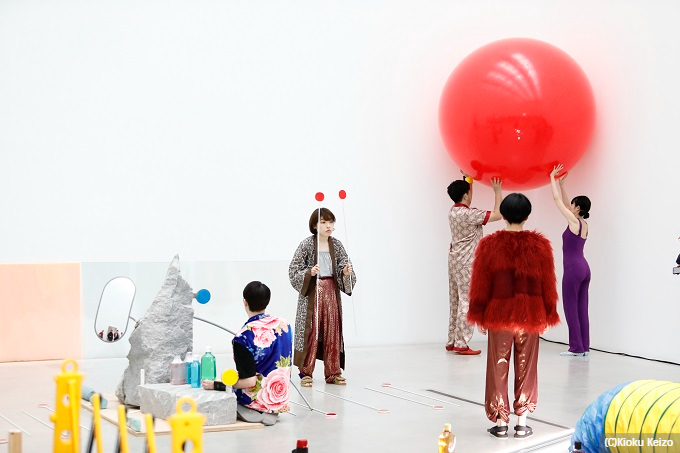 chelfitsch & Kaneuji Teppei "Eraser Forest"
chelfitsch & Kaneuji Teppei "Eraser Forest"Photo: Kioku Keizo
(Photo courtesy of the 21st Century Museum of Contemporary Art, Kanazawa)
In addition to working with the company, some of my other activities include the debut of "Unfulfilled Ghost and Monster - ZAHA / TSURUGA"at the KAAT Kanagawa Arts Theatre in June 2020, but the performance was cancelled with the opportunity for postponement. But since we have time now, we thought it was better to continually explore creation even if it meant doing so online. So we pursued the online process, initially conducting workshops, and then creating works using scripts two or three times each week between April and June. We also distributed a video of the works in progress for a limited time.
The performances for a dance project with ballet dancer Sakai Hana and cellist Shika Udai were also postponed, but we continued to work on the creative part of that project online once a week. Through this, even though it isn't yet complete, we can already see how the work will move forward with this concept.
I've also been writing a novel. Because I haven't had this much free time in recent years, I have been taking it easy, reading books and vaguely thinking about concepts for future projects. I was able to use this time like a sabbatical, for which I'm really grateful.
This was something that was decided very quickly, but I went to Munich, Germany in July. There is a public theater called the Münchner Kammerspiele, and since 2016 its artistic director, Matthias Lilienthal, had continually entrusted me with performances that would become part of the theater's repertory. Since his term there was coming to an end, we were preparing a special program, but due to the pandemic this became impossible. In an attempt to do something else instead, we planned a performance in the Munich Olympic Stadium, and I was tasked with creation and direction. With five days of rehearsal and a single performance, I think we were able to produce something interesting in an extraordinary environment.
――You were quick to distribute "Eraser Fields" and "The Ghosts of the Performance of'Unfulfilled Ghost and Monster"' online during the state of emergency. I think their success derived from the fact that you have been working on 〈EIZO-Theater〉 (video theater) in which you present exhibitions of works using video projections. What are your thoughts on that?
We have been working on video theater for several years. They are actually video installations, in which we project a video of actors' performances in an exhibition space and create fiction in the actual space as a phenomenon. We call it 〈EIZO-Theater〉that is, a play. I think this experience proved quite effective under the current conditions. It was particularly successful in "The Ghosts of the performance of 'Unfulfilled Ghost and Monster '." We wouldn't have been able to do so without having experimented with EIZO-Theater beforehand.
――I get the impression that you were able to deliver content immediately in these extraordinary times because you have for years worked to expand presentation techniques for plays.
Rather than expanding presentation techniques, I see it as expanding my definition of plays. I think this definitely is what allowed us to respond relatively quickly this time. "Plays" usually involve holding performances at a theater―a physical location―and having an audience gather there. For me, plays encompass the whole process, from a viewpoint and an understanding gained and developed through the experience of creation to a basis for judgement applied for creation. When using this perspective to create something, I think we can call the resulting creation a "play." In that respect, I think it is possible to call something that doesn't exactly fit the definition of a play a "play." I applied this perspective to create my plays for video distribution.
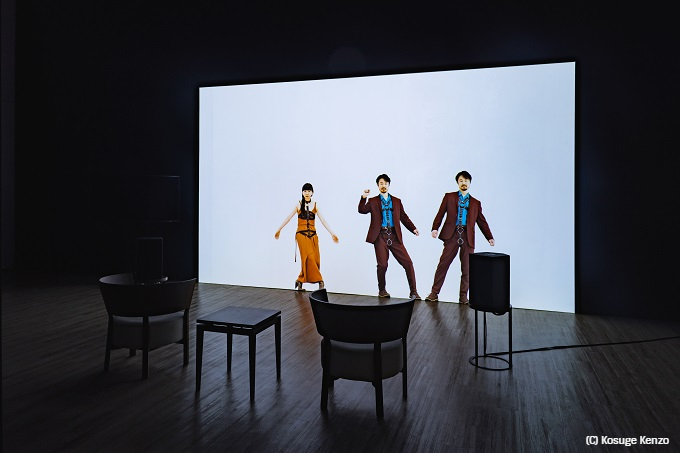 "Dialogue of Revolution" from chelfitsch's 〈EIZO-Theater〉 "The Landscape, the World, and Accidents: Everything That Happens Outside of This Room" 2020 at Sapporo Cultural Arts Community Center SCARTS
"Dialogue of Revolution" from chelfitsch's 〈EIZO-Theater〉 "The Landscape, the World, and Accidents: Everything That Happens Outside of This Room" 2020 at Sapporo Cultural Arts Community Center SCARTSPhoto by Kosuge Kenzo
――Have you ever remotely created before?
Never. When I create plays, it is necessary to share the things that I value with everyone, especially when it's with a cast that I work with for the first time. I want them to learn, understand and put this into their performance. To do so, we hold workshops in which I ask the actors to actually make movements. Having said that, we are able to do this process even in a remote environment.
But I am not quite sure how precisely we can recreate the realism or details online like we could when we hold a performance at a theater. That's not to say it's impossible online. It may be just a technical problem with broadband speeds. If that's the case, then it's possible that this problem can be solved at some point.
――There seem to be some parts of so-called "normal performances" that can't be replicated remotely, like sharing the same time, space and immersive experiences.
We need to seriously consider the importance of performances and audiences sharing a physical space. In doing so, we have to be careful not to overemphasize the sanctity of physical locations. I think it would be great if the current situation became an opportunity to encourage playwrights to consider their awareness of this issue.
――Do you feel the pandemic led you to new discoveries?
I got serious about working on something that I used to think I didn't have to. In that sense, new discoveries are something born naturally, not something forced upon. I've been doing it; however, it's not just me, but a variety of people here and there.
For me, there are two types of plays. One is a performance as a form of expression. The other is a performance that encompasses the entire process, from a viewpoint and an understanding to a basis for judgement, to realize it. The former is what couldn't happen given the situation. With regard to the latter, I think that the pandemic has actually caused me to think about such matters.
――What are your thoughts on society during the pandemic?
It was impossible to know beforehand what kinds of narratives would take form in a situation where no one knew what was going to happen. Then it became clearer little by little, and people began to follow suit. I feel like I witnessed an undulating wave in front of my eyes. I was caught in that wave as well. In the beginning, word spread that cloth masks were almost meaningless. But now everyone wears them, including me.
――In your play, "Current Location," there is a scene where a character questions how to confront someone who engages with rumors in society in a different way. Likewise, the pandemic has given rise to a division due to differences in awareness. What do you think about this overlapping sense?
It's not like the current situation has made me think more about division. I thought more about that in 2011, when there was the accident at the Fukushima Daiichi Nuclear Power Plant, which triggered me to write the script for "Current Location."
――What kind of changes do you think will come from our experiences during this pandemic?
I have absolutely no idea! But I am worried that there might be less opportunities for people with different sets of values to interact and thereby evoke a positive influence on each other. It would be a real shame if that happens.
When a work created within one context, for example modern Japanese society, is placed in a different context, the work functions in a way that is unique to the different context. I think it is really interesting and has tremendous value.
Also, I don't think this can happen unless people actually physically move from the context they are in to another different location. But the world may be transitioning toward a place where the movement of people isn't positively regarded, not just during the pandemic, but from the perspective of consideration for the global environment.
――So you mean physically going somewhere and interacting.
It may also be possible to do so online. But based only on my own experience, physical movement is a must.
――As a physical experience on location, I guess it affects how you understand other people's background and the mood.
To me, that's one of the things I'm most happy about experiencing. When I see my own play being performed in a place with a different context that is unknown to me, I get the sense that I am also somehow influenced by how the audience there sees my work.
――Do you feel that this kind of border crossing is something rather natural, or something that has little meaning?
I don't think that I am crossing borders. I don't think I can do such a grand thing.
――I know you've created works with a strong connection to social themes. Why is that?
I don't think there are only two options: plays about society, or plays not about society. In fact, I don't really consider my works to be social. I don't really think that "I'm going to make a social play!" Or perhaps, you could say that I don't understand what it means to create a play that isn't about society.
Just maybe, the relationship I want to create with the audience through performances of my plays is more about tension than empathy.
――Since "Current Location," you have said that you were working to create fiction to build a sense of tension. Have you continued to take this approach?
I did say that around the time of "Current Location." Have I maintained the same stance? I really don't know. But I do think that I am always aware of the fact that the phenomenon of performance only occurs within the relationship with the audience. Maybe that kind of attitude is a social one.
――You apply forms of expression used in Noh and Kyogen. How do you link what you have discovered in these forms to your plays?
I felt a great potential in the Noh format to deal with political elements. I don't really care that Noh should be expressed in this or that way because it has the authenticity as the oldest classical theater in Japan, or about its subtlety and profoundness. What impressed me most was that a ghost talking about his or her own death sounded extremely political.
――In Noh, a person's death is intertwined with social circumstances and his or her ghost speaks about that death. You are saying that it can become something political by turning that into a play and making it public?
Yes, that's right.
――Do you plan to make works that incorporate elements of Noh?
Yes, if I have the opportunity. I think that Japan alone still has many ghosts that ought to be brought to light.
――You've said that with the "Eraser" series, you've made the relationship between people and objects equal. Why are you looking at objects now?
I was overwhelmed by the reconstruction work from tsunami damage in Rikuzentakata in Iwate Prefecture. That experience prompted me to write the play. They raised the ground 12 meters so that people could live in this area again. The soil used to elevate the land came from a nearby mountain. In other words, a mountain was dissipated. For me, it was an overwhelming experience to witness such a large-scale project in progress solely from a human-centric perspective. I didn't know how to take it in.
From the confusion I felt then, I wanted to create something. I thought it was an interesting challenge if that "something" was a play. That's because plays are an extremely human-centric format. How can I create a narrative that isn't human-centric in a play format? I had absolutely no idea at first, of course. I just knew that we needed non-human objects. That's why I decided to collaborate with artist and sculptor Kaneuji Teppei.
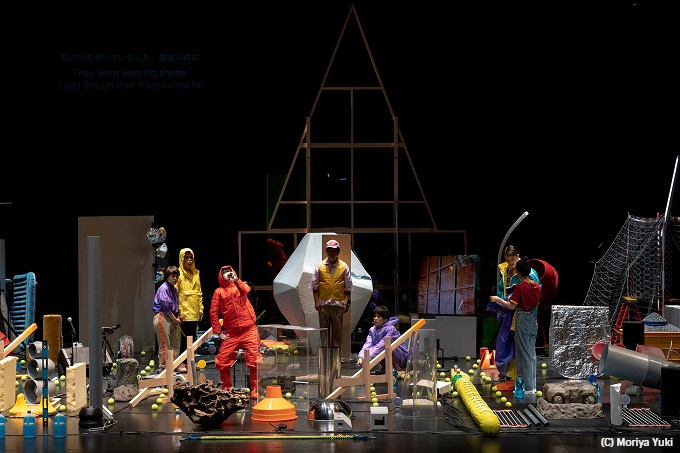 chelfitsch & Kaneuji Teppei "Eraser Mountain" 2019 at ROHM Theatre Kyoto
chelfitsch & Kaneuji Teppei "Eraser Mountain" 2019 at ROHM Theatre KyotoPhoto: Moriya Yuki
(Photo courtesy of the KYOTO EXPERIMENT office)
――The targets of your non-human-centric plays are not just people but objects as well. When the audience see such a play as people, is it different from when they see a play made by people for people? Do you think there is a chance that it may sometimes make people uncomfortable?
It's up to each person. There are two ways to present the play: delivering a narrative that humans are not the center of the universe by optimizing it for humans; or making people realize that they are not the center of the universe by showing them something that isn't optimized for them. I wonder which one "Eraser Mountain" was. I can't really say, but I'm more inclined to say it was the latter. If that's the case, then I think it's natural that there will be people who don't understand why they need to see a play like that.
――How will the method of creating plays change after the pandemic?
I can't really tell, but I'm sure new formats will appear as a result of dealing with the awareness of issues brought about by the current situation. Even if the formats aren't new, there will be works filled with strength as a result of grappling with these issues. Also, these can be expected to offer a foundation for future trends in theater. I want to continue trying new things so that I can create something in my own way amid those trends.
- *¹ chelfitsch & Kaneuji Teppei "Eraser Fields": distributed on an irregular basis on YouTube starting May 23, 2020
https://chelfitsch.net/en/activity/2020/05/eraser-fields.html
chelfitsch official website: https://chelfitsch.net/en/
Online interview in October 2020
Interview/text: Terae Hitomi (Japan Foundation Communication Center)
Related Articles
Keywords
Back Issues
- 2025.6. 9 Creating a World Tog…
- 2024.10.25 My Life in Japan, Li…
- 2024.5.24 The 50th Japan Found…
- 2024.5.24 The 50th Japan Found…
- 2024.5. 2 People-to-People Exc…
- 2024.5. 2 People-to-People Exc…
- 2023.12. 7 Movie Theaters aroun…
- 2023.6.16 The 49th Japan Found…
- 2023.4.24 The 49th Japan Found…
- 2022.12.27 Living Together with…


